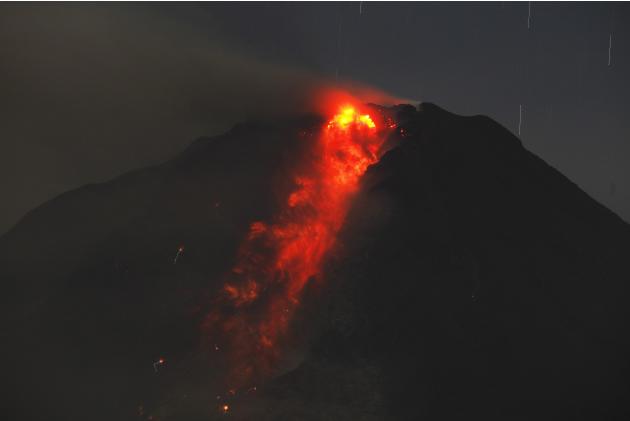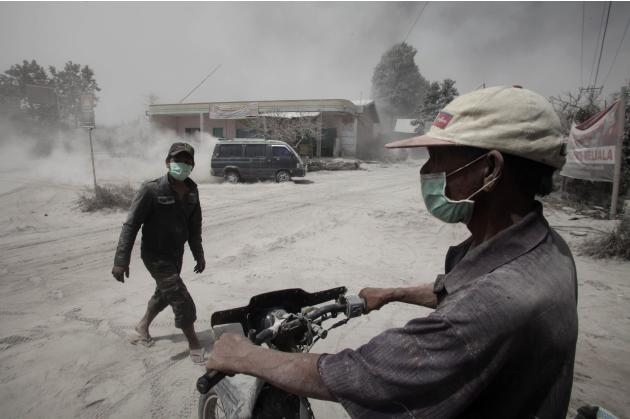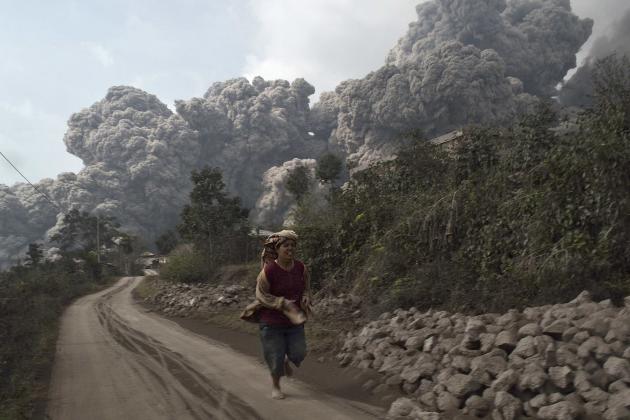





MOUNT SINABUNG, Indonesia - An Indonesian volcano that has been rumbling for months unleased a major eruption Saturday, killing 14 people just a day after authorities allowed thousands of villagers who had been evacuated to return to its slopes, saying that activity was decreasing, officials said.
Among the dead on Mount Sinabung were a local television journalist and four high-school students and their teacher who were visiting the mountain to see the eruptions up close, said National Disaster Mitigation Agency spokesman Sutopo Purwo Nugroho. At least three other people were injured, and authorities feared the death toll would rise.Sinabung in western Sumatra has been erupting for four months, sending lava and searing gas and rocks rolling down its southern slopes. Authorities had evacuated more than 30,000 people, housing them in cramped tents, schools and public buildings. Many have been desperate to return to check on homes and farms, presenting a dilemma for the government.
On Friday, authorities allowed nearly 14,000 people living outside a five-kilometre (three-mile) danger zone to return home after volcanic activity decreased. Others living close to the peak have been returning to their homes over the past four months despite the dangers.
On Saturday, a series of huge blasts and eruptions thundered from the 2,600-meter (8,530-foot) -high volcano, sending lava and pyroclastic flows up to 4.5 kilometres (2.8 miles) away, Nugroho said. Television footage showed villages, farms and trees around the volcano covered in thick grey ash.
Following the eruption, all those who had been allowed to return home Friday were ordered back into evacuation centres.
"The death toll is likely to rise as many people are reported still missing and the darkness hampered our rescue efforts," said Lt. Col. Asep Sukarna, who led the operation to retrieve the charred corpses some three kilometres (two miles) from the volcano's peak.
Indonesia is prone to seismic upheaval due to its location on the Pacific "Ring of Fire," an arc of volcanoes and fault lines encircling the Pacific Basin. Mount Sinabung is among about 130 active volcanoes in Indonesia and has sporadically erupted since September.
In 2010, 324 people killed over two months when Indonesia's most volatile volcano, Mount Merapi, roared into life. As now in Sinabung, authorities struggled to keep people away from the mountain. Scientists monitor Merapi, Sinabung and other Indonesian volcanos nonstop, but predicting their activity with any accuracy is all but impossible.
The latest eruptions came just a week after President Susilo Bambang Yudhoyono visited displaced villagers in Sinabung and pledged to relocate them away from the mountain. Villagers are attracted to the slopes of volcanoes because the eruptions make for fertile soil.
Sinabung's last major eruption was in August 2010. Prior to that the volcano had been quiet for four centuries. Seismic activity has been increasing around the world and experts have been warning that a super volcanic eruption is possible which could have global repercussions.
IS GLOBAL WARMING RESPONSIBLE FOR INCREASED SEISMIC ACTIVITY??
The melting of glaciers driven by global warming portends a seismically turbulent future. When glaciers melt, the massive weight on the Earth's crust is reduced, and the crust “bounces” back in what scientists call an "isostatic rebound.” This process can reactivate faults, increase seismic activity, and lift pressure on magma chambers that feed volcanoes. This has happened several times throughout Earth's history, and the evidence suggests that it is starting to happen again.
No comments:
Post a Comment
Through this ever open gate
None come too early
None too late
Thanks for dropping in ... the PICs